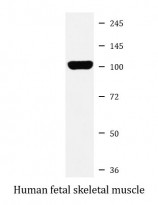ARG41893
anti-LGR5 / GPR49 antibody
anti-LGR5 / GPR49 antibody for Immunoprecipitation,Western blot and Human,Mouse,Rat
Overview
| Product Description | Rabbit Polyclonal antibody recognizes LGR5 / GPR49 |
|---|---|
| Tested Reactivity | Hu, Ms, Rat |
| Tested Application | IP, WB |
| Host | Rabbit |
| Clonality | Polyclonal |
| Isotype | IgG |
| Target Name | LGR5 / GPR49 |
| Antigen Species | Human |
| Immunogen | Synthetic peptide of Human LGR5 / GPR49. |
| Conjugation | Un-conjugated |
| Alternate Names | Leucine-rich repeat-containing G-protein coupled receptor 5; G-protein coupled receptor 49; GRP49; G-protein coupled receptor 67; GPR67; GPR49; HG38; G-protein coupled receptor HG38; FEX |
Application Instructions
| Application Suggestion |
|
||||||
|---|---|---|---|---|---|---|---|
| Application Note | * The dilutions indicate recommended starting dilutions and the optimal dilutions or concentrations should be determined by the scientist. | ||||||
| Positive Control | Human fetal skeletal muscle | ||||||
| Observed Size | ~ 100 kDa |
Properties
| Form | Liquid |
|---|---|
| Purification | Affinity purified. |
| Buffer | PBS (pH 7.4), 150 mM NaCl, 0.02% Sodium azide and 50% Glycerol. |
| Preservative | 0.02% Sodium azide |
| Stabilizer | 50% Glycerol |
| Storage Instruction | For continuous use, store undiluted antibody at 2-8°C for up to a week. For long-term storage, aliquot and store at -20°C. Storage in frost free freezers is not recommended. Avoid repeated freeze/thaw cycles. Suggest spin the vial prior to opening. The antibody solution should be gently mixed before use. |
| Note | For laboratory research only, not for drug, diagnostic or other use. |
Bioinformation
| Database Links | |
|---|---|
| Gene Symbol | LGR5 |
| Gene Full Name | leucine-rich repeat containing G protein-coupled receptor 5 |
| Background | The protein encoded by this gene is a leucine-rich repeat-containing receptor (LGR) and member of the G protein-coupled, 7-transmembrane receptor (GPCR) superfamily. The encoded protein is a receptor for R-spondins and is involved in the canonical Wnt signaling pathway. This protein plays a role in the formation and maintenance of adult intestinal stem cells during postembryonic development. Several transcript variants encoding different isoforms have been found for this gene. [provided by RefSeq, Sep 2015] |
| Function | Receptor for R-spondins that potentiates the canonical Wnt signaling pathway and acts as a stem cell marker of the intestinal epithelium and the hair follicle. Upon binding to R-spondins (RSPO1, RSPO2, RSPO3 or RSPO4), associates with phosphorylated LRP6 and frizzled receptors that are activated by extracellular Wnt receptors, triggering the canonical Wnt signaling pathway to increase expression of target genes. In contrast to classical G-protein coupled receptors, does not activate heterotrimeric G-proteins to transduce the signal. Involved in the development and/or maintenance of the adult intestinal stem cells during postembryonic development. [UniProt] |
| Cellular Localization | Cell membrane; Multi-pass membrane protein. Golgi apparatus, trans-Golgi network membrane; Multi-pass membrane protein. Note=Rapidly and constitutively internalized to the trans-Golgi network at steady state. Internalization to the trans-Golgi network may be the result of phosphorylation at Ser-861 and Ser-864; however, the phosphorylation event has not been proven (PubMed:23439653). [UniProt] |
| Calculated MW | 100 kDa |
Images (1) Click the Picture to Zoom In






